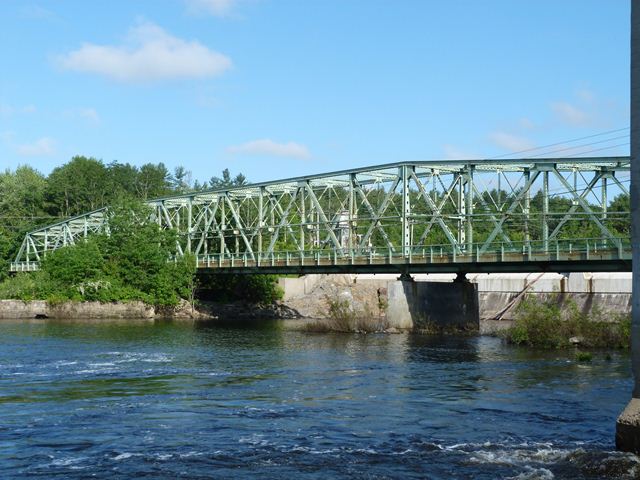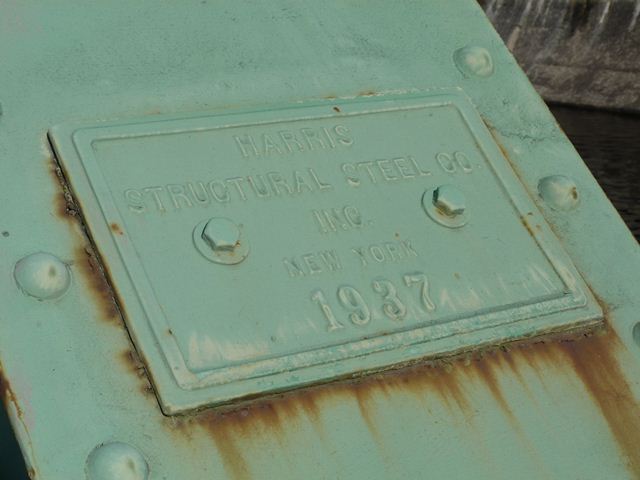We Recommend:
Bach Steel - Experts at historic truss bridge restoration.
BridgeHunter.com Phase 1 is released to the public! - Visit Now
West Buxton Bridge

Primary Photographer(s): Nathan Holth
Bridge Documented: June 16, 2012
Hollis and Buxton: York County, Maine: United States
Metal Continuous Rivet-Connected Polygonal Warren Through Truss, Fixed and Approach Spans: Metal Stringer (Multi-Beam), Fixed
1937 By Builder/Contractor: Harris Structural Steel Company of New York, New York
1988
234.0 Feet (71.3 Meters)
607.0 Feet (185 Meters)
22 Feet (6.71 Meters)
1 Main Span(s) and 1 Approach Span(s)
3340

View Information About HSR Ratings
Bridge Documentation
View Archived National Bridge Inventory Report - Has Additional Details and Evaluation
This bridge is one of only three known examples of continuous trusses in Maine that display the appearance of a very long simple span truss supported by piers. In this design, the truss has no "cantilever truss shape." Continuous trusses of this design are also extremely rare nationwide. Each of Maine's three examples of this design are distinctly unique, each employing different truss arrangements. Despite that fact, all three were built at around the same time. It is unknown why there is such a variance in design. The other two bridges are the Lisbon Falls Bridge and the Bar Mills Bridge. Because each bridge is rare, both in Maine and nationwide, and given the unique appearance of each, the preservation of each example should be given a high priority.
This bridge has three spans and is of a symmetrical design. The top chord is polygonal throughout the bridge, but between the top chord and end posts, there are only five slopes, similar to a Camelback type of truss. The eastern end of the bridge has a steel stringer approach span. At the western end of this steel stringer span is a stone pier that appears to predate this bridge and was likely part of the previous bridge at this location.
Information and Findings From Maine's Historic Bridge InventoryDiscussion of Bridge The 1937, continuous, riveted, Warren thru truss bridge is technologically significant as an early application of the continuous design. The first examples in Maine were for replacements of bridges lost in the flood of March, 1936. This is one of 25 bridges built by MSHC to replace lost bridges, and it is one of three continuous-design Warren truss bridges built by the commission in 1936-37 as flood replacement bridges. All three early examples, including #3333 and #3334, are historically and technologically significant. The significance of the bridge is linked to the continuous design. The bridge is judged to have average preservation priority because an example of a bridge type that is considered common in the state. Bridge Considered Historic By Survey: Yes |
![]()
Photo Galleries and Videos: West Buxton Bridge
Structure Overview
Original / Full Size PhotosA collection of overview photos that show the bridge as a whole and general areas of the bridge. This gallery offers photos in the highest available resolution and file size in a touch-friendly popup viewer.
Alternatively, Browse Without Using Viewer
![]()
Structure Details
Original / Full Size PhotosA collection of detail photos that document the parts, construction, and condition of the bridge. This gallery offers photos in the highest available resolution and file size in a touch-friendly popup viewer.
Alternatively, Browse Without Using Viewer
![]()
Structure Overview
Mobile Optimized PhotosA collection of overview photos that show the bridge as a whole and general areas of the bridge. This gallery features data-friendly, fast-loading photos in a touch-friendly popup viewer.
Alternatively, Browse Without Using Viewer
![]()
Structure Details
Mobile Optimized PhotosA collection of detail photos that document the parts, construction, and condition of the bridge. This gallery features data-friendly, fast-loading photos in a touch-friendly popup viewer.
Alternatively, Browse Without Using Viewer
![]()
Eastbound Crossing
Full Motion VideoStreaming video of the bridge. Also includes a higher quality downloadable video for greater clarity or offline viewing.
![]()
Maps and Links: West Buxton Bridge
Coordinates (Latitude, Longitude):
Search For Additional Bridge Listings:
Bridgehunter.com: View listed bridges within 0.5 miles (0.8 kilometers) of this bridge.
Bridgehunter.com: View listed bridges within 10 miles (16 kilometers) of this bridge.
Additional Maps:
Google Streetview (If Available)
GeoHack (Additional Links and Coordinates)
Apple Maps (Via DuckDuckGo Search)
Apple Maps (Apple devices only)
Android: Open Location In Your Map or GPS App
Flickr Gallery (Find Nearby Photos)
Wikimedia Commons (Find Nearby Photos)
Directions Via Sygic For Android
Directions Via Sygic For iOS and Android Dolphin Browser
USGS National Map (United States Only)
Historical USGS Topo Maps (United States Only)
Historic Aerials (United States Only)
CalTopo Maps (United States Only)



